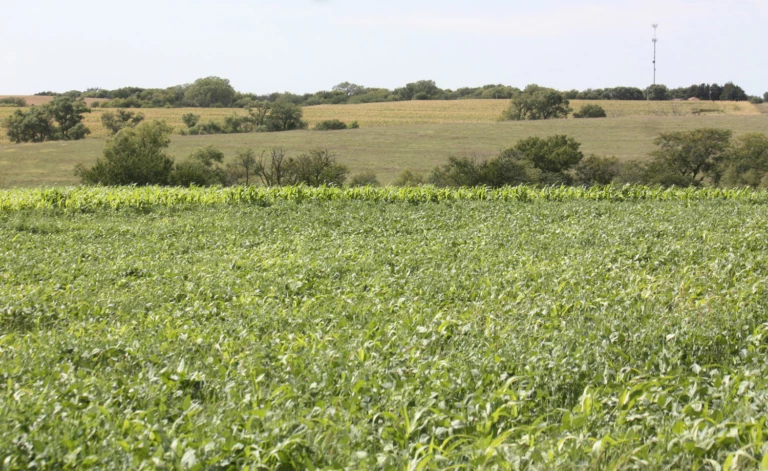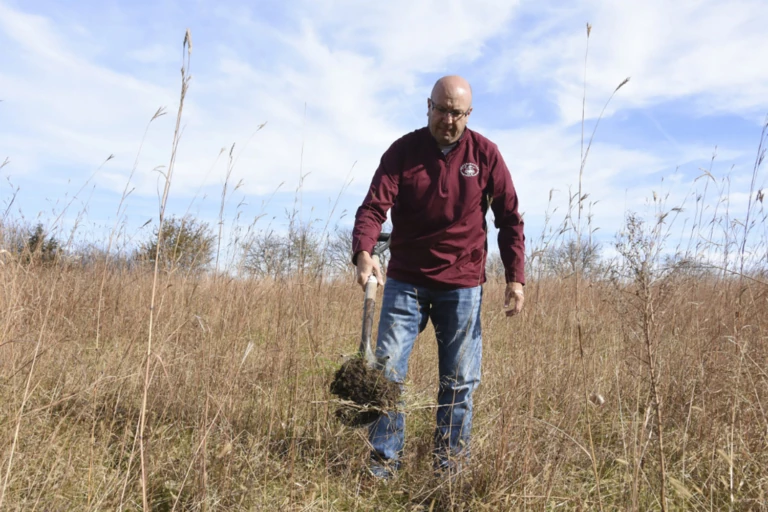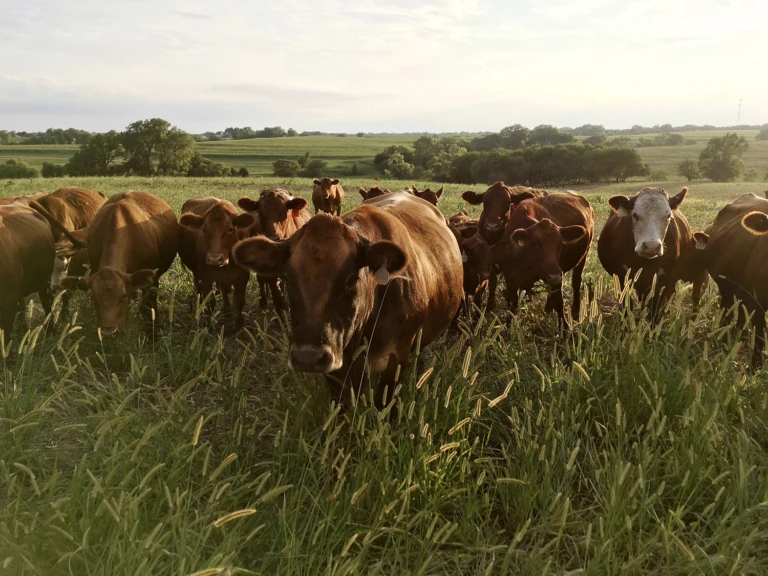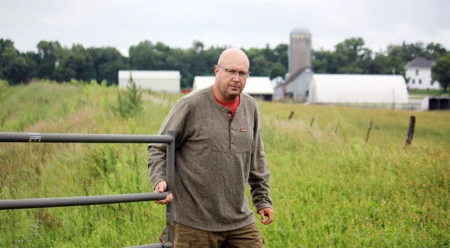Don’t Till On Me
Del Ficke is a soil junkie.
“It’s like a drug the first time you feel real good soil,” he says. “You get it in your hands and can feel how good it is. You can smell it and taste it. You just want to take a big old hit of it.”
Stocky with a cleanly shaved head, smart, wire-rimmed glasses and a polo shirt, Ficke, 52, looks like someone who would be more at home in a corporate boardroom than in a field filled with sorghum, corn and other grains. But Ficke is a fifth-generation Nebraskan farmer whose land in the rolling clay hills outside Lincoln has been worked by his family since they arrived as homesteaders in 1869. He grew up with a love for the outdoors and was taught from an early age the importance of respecting the land. His obsession with soil really took hold in 1986 when, constantly strapped for time dealing with a farm that stretched over thousands of acres and three counties, he convinced his father to put 100 percent of their land in no till and see what happened.
“No till” operates on the idea that doing less will do more for your crops and is one of the hallmarks of regenerative agriculture—an approach to farming that, among other things, focuses on topsoil regeneration, increasing biodiversity, improving the water cycle, strengthening the health of soil and increasing crops’ resilience to climate change. Tillage churns up the land with a tractor or cultipacker for high crop yields today at the expense of compacted, depleted soil tomorrow. Regenerative’s no-till method requires farmers to take a hands-off approach and leave their soil undisturbed year in and year out. Among the benefits of a no-till technique are that the soil retains water, nutrients and vital organic materials lost though erosion or when plowed by tractors. While this does make the soil more vulnerable to plant-based diseases, it also improves the soil’s biological fertility and, in the long term, makes for a more resilient and healthy soil. There’s a reason why untouched soil in wild places stays put and thrives.

Ficke grows grasses and corn to serve a dual purpose—as feed for his cattle, but also as cover crops that help store moisture and nutrients in the soil. Courtesy Del Ficke
Ficke didn’t have to wait long for his move to no till to pay dividends as he implemented the technique right before a major drought that wreaked havoc on neighboring plots. The no-till soil on Ficke’s farm in 1986 ended up producing 77 bushels of corn per acre, compared to just 12 bushels per acre on surrounding farms. “The year after we went no till, every farm within 10 miles of ours went no till,” Ficke says. “We did so well that year that everybody followed suit.”
Even without a drought, no till spares farmers time and money. “Not tilling not only saves time, but it really saves moisture, which is so important since we don’t irrigate. Plus, there’s fuel savings, and it eliminates the need to purchase tillage equipment and large, expensive tractors.”
Despite Ficke’s initial success with regenerative farming and convincing his neighbors to join in, resistance from the agricultural establishment caused him to put the experiment on hold. This was before organic produce became a cause célèbre and the farming industry at that time—as it still very much does today—put a major emphasis on big farms, big yields and big overheads. Farmers were told they needed to use chemicals and fertilizers to keep their crops alive and thriving; they needed the latest tractors and other farming equipment to keep their rolling fields looking like an advertisement for the Nebraska Farm Bureau; and that industrializing how they raise livestock was the only way to be profitable in an industry that runs on razor-thin margins.
“The doubters and naysayers were everywhere, especially from those people embedded into the system,” Ficke says, adding that many farmers to this day have a sort of “Stockholm syndrome where they’re in love with their captors,” (i.e. the companies pushing the chemicals and new equipment on them).
It took a forced departure from farm work in the late 1990s to open Ficke’s eyes to how people in the United States view farming and how he could change this for the better. A series of back injuries and surgeries, including two crushed vertebrae, made farm work almost unbearable for him, and in 1999, Ficke was forced to take a seat on the sidelines. He went back to school—earning degrees in radiology and hospital administration before ultimately taking a job managing a medical clinic in Lincoln. It was during his time in Lincoln that Ficke was exposed to people outside the insular farming world and began to see that not everyone held his family’s line of work in such reverence as he did.

Ficke wryly refers to his 700 acre regenerative farm as his collection of “hills and rocks.” Here, he shows the rewards of leaving well enough alone. Courtesy Del Ficke
“I realized that a lot of people didn’t think too highly of farmers and some of the more hardline practices the industry uses,” he says, specifically mentioning concerns people had about animal welfare and the use of pesticides in vegetables. “The negative public perception was a big eye-opener for me. I began to realize that we had to do things better, and we could do it better.”
Ficke gradually began to move back toward farm work and implement those regenerative ideas that had been stirring in his head since he introduced no till to his family’s land in the mid-80s. The radical moves were not simple and there were periods of trial and error that Ficke chalks up to his nascent experience with regenerative farming. He cautions any farmer looking to convert to regenerative to study up and not be afraid to ask questions from stewards —like himself—already practicing regenerative.
“Any failures were my own damn fault as everything is cyclical in this world, and I would study a lot harder with what other people were doing if I could go back,” he says. “Any failure is chalked up to education, and we know that isn’t cheap.”
More than 30 years after Ficke first went no till, his family’s farm looks almost nothing like most other farms in Nebraska. He has reduced his land holdings to just 700 acres that he proudly refers to as his collection of “hills and rocks.” Gone is the majority of the multi-thousand-acre, county-spanning farmland that comprised Ficke’s operation. Also absent are the multiple tractors, plows, combines, shining bins and other seemingly required equipment used to maintain that land. Along with scaling back on farming equipment, Ficke also cut down the family’s cattle operation to a more manageable size and implemented a number of other regenerative processes like cover cropping, intercropping and letting animals graze freely. While slashing almost three-quarters of his farmland seems counterproductive, Ficke says that he has seen his profits rise 70 percent since his regenerative consolidation.
“Cutting back was what I wanted to do,” he says. “You can scale back and make as much or more money, but if you want to get bigger, you are just doing better for the soil on more acres. I prefer more people having the chance to farm, and for me, downsizing allowed that.”

Ficke’s cattle free-range graze on grass and bales of hay, which are returned to the soil in the form of cow manure and urine. Courtesy Del Ficke
Ficke ditched the cow pens and feedlots in favor of free-range grazing on grass and bales of hay. He whittled down his fleet of farm machinery to one tractor for moving hay and—thanks in large part to no-till techniques and copious amounts of cow poo—he was able to drastically reduce the use of fertilizers and herbicides. Ficke now estimates that he’s reduced his dependence on crop fertilizers by 95 percent thanks to the use of cow manure and urine, and he only uses herbicides on what he calls “rescue plants.”
“We do everything regenerative we can: using cover crops, analyzing animal impact, keeping bees, rotating row crop acres back to pastures, adding multispecies such as chickens and hogs, gardening and planting fruit trees,” Ficke says. “Regenerative is the only way to go. Regenerating the soil regenerates the soul and everything on this Earth benefits.”
Ficke has seen some astounding transformations take place on the family farm since implementing regenerative practices and—thanks in large part to the time freed up from his schedule due to the more laissez-faire approach to agriculture—he wants to spread the gospel.
“I spend more time talking to wives who never see their husbands because they’re out working from dawn to dusk, and sometimes later than that, than I do talking with the husbands doing the farming,” he said. “I take a philosophical approach to how we can correct society: If you fix the soil, you can fix the family.”
Ficke has been on too many farms and seen the sway that big agriculture’s lobbyists and sales reps have in both farmhouses and Congress to know that it will be a long time—if ever—before regenerative becomes the norm of the country’s farms. But he also believes that if farmers implemented just one regenerative technique onto their land, they would see a drastic improvement in their yield, and it would remedy a lot of the environmental harm and soil degradation that comes along with today’s modern farming techniques. “You don’t have to go all the way and become a completely organic farm,” Ficke says. “But if every farmer in the world changed just 10 percent of their farms to regenerative, we would fix this problem.”

